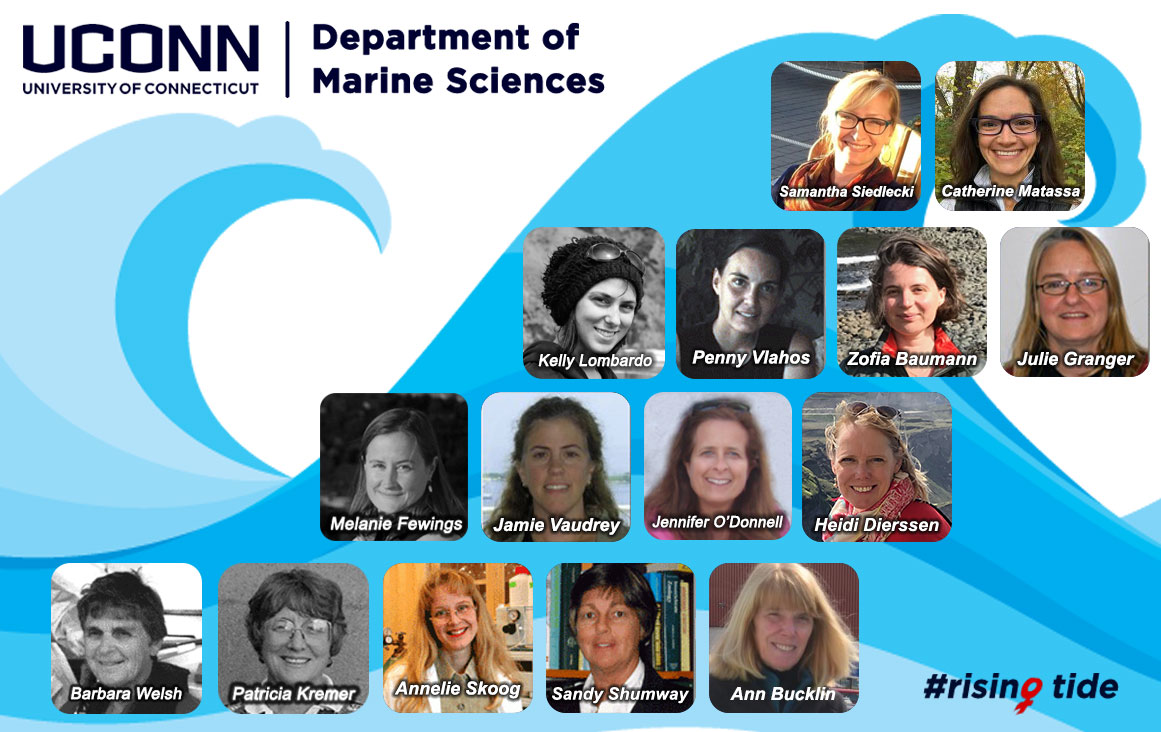It has been over 50 years since the University of Connecticut established Avery Point as a regional campus and nearly 40 years since the formalization of the Department of Marine Sciences (DMS). At that time, national feminist and civil rights movements were in full swing as well. In the decades that followed, especially the past 20 years, a primary focus of these movements has been increasing and retaining diversity in science, technology, engineering, and mathematics (STEM), which includes oceanography. Since the early 2000s, DMS has successfully narrowed the gender-gap among faculty members.
Barbara Welsh was the first female faculty member in DMS. She was hired in the 1980s and helped establish hypoxia monitoring and nitrogen management programs in Long Island Sound. Her research revealed phytoplankton blooms and the resulting alarmingly low oxygen concentrations in Western Long Island Sound in the summer.
The next female professor to join was Annelie Skoog, who studies marine organic matter cycling. Another early female leader was Associate Professor in Residence Patricia Kremer, who studied gelatinous plankton. After Barbara retired, Annelie remained the only tenured female faculty member. All other women faculty were research scientists and not professors. The most common title being Research Professor, with levels assistant, associate and full.
A few members of the department recalled a faculty meeting in 2002, in which half the members present were women. However, as the only female tenure-track professor present, Annelie was the only woman allowed a vote.
As a part of larger UConn initiatives to promote diversity and opportunities for underrepresented groups, DMS sought to grow as a department and recruit talented new faculty for hire. In 2005, Ann Bucklin became the first female department head and lead many efforts to formalize department proceedings.
Since then, Heidi Dierssen, Penny Vlahos, Julie Granger, Kelly Lombardo (who moved to Penn State University in 2019), Melanie Fewings (who moved to Oregon State University in 2018), Samantha Siedlecki, and Catherine Matassa have joined the tenure-track faculty ranks.
Additionally, Sandy Shumway, Jamie Vaudrey, and Jennifer O’Donnell have been members of the research faculty and key contributors to the Department. Claudia Koerting has been an integral part of developing the undergraduate program and maintaining instrumentation. A partnership with Mystic Aquarium added four women – all active and successful marine researchers – as affiliate faculty-in-residence: Tracy Romano, Maureen Driscoll, Laura Thompson, and Ebru Unal.
 After conversations with many of these stellar scientists, it became clear that the culture in science overall has shifted greatly. Both Claudia and Penny commented that neither of them had any female professors throughout their entire academic careers. Whereas current graduate and undergraduate students can attest that female professors in the sciences are now entirely usual. However, disparities among different scientific disciplines remain. Today, the percent of people in physics and engineering identifying as female at the doctorate level is approximately 20% (Women in Physics and Astronomy 2019 Report, American Institute of Physics).
After conversations with many of these stellar scientists, it became clear that the culture in science overall has shifted greatly. Both Claudia and Penny commented that neither of them had any female professors throughout their entire academic careers. Whereas current graduate and undergraduate students can attest that female professors in the sciences are now entirely usual. However, disparities among different scientific disciplines remain. Today, the percent of people in physics and engineering identifying as female at the doctorate level is approximately 20% (Women in Physics and Astronomy 2019 Report, American Institute of Physics).
The culture that has been cultivated and continues to grow in DMS strives for diversity, inclusion, and equity on all academic levels including students, staff, and faculty.
On a final note, here are some statistics based on current departmental records. As of April 2020, all four research staff, six of eight postdoctoral research associates, 7 of 18 tenured or tenure track faculty, and four of five research faculty are women.

